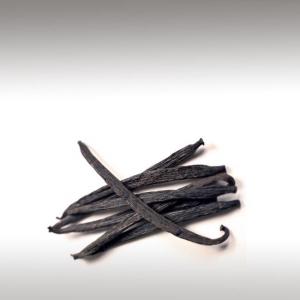
MADAGASCAR BOURBON VANILLA BEANS (VANILLA PLANIFOLIA) - INGREDIENTS

BASE / GENERAL DATA
Information submited: September 25, 2014 Modified: May 30, 2018 By: OperaDreamhouse
Vanilla is a flavor derived from orchids of the genus Vanilla, primarily from the Mexican species, flat-leaved Vanilla (Vanilla Planifolia). The word Vanilla, derived from the diminutive of the Spanish word Vaina (Vaina itself meaning Sheath or Pod), simply translates as little pod.
The majority of the world's Vanilla is the Vanilla Planifolia species, more commonly known as Bourbonvanilla (after the former name of Réunion, Île Bourbon) or Madagascar Vanilla, which is produced in Madagascar and neighboring islands in the southwestern Indian Ocean, and in Indonesia.
Vanilla grows as a vine, climbing up an existing tree (also called a tutor), pole, or other support. The distinctive flavour compounds are found in the fruit, which results from the pollination of the flower. One flower produces one fruit. Vanilla Planifolia flowers are hermaphroditic: They carry both male (anther) and female (stigma) organs.
Stages of production :
The Vanilla fruit grows quickly on the vine, but is not ready for harvest until maturity - approximately six months. Harvesting Vanilla fruits is as labor-intensive as pollinating the blossoms. Immature dark green pods are not harvested. Pale yellow discoloration that commences at the distal end of the fruits is an indication of the maturity of pods. Each fruit ripens at its own time, requiring a daily harvest. To ensure the finest flavor from every fruit, each individual pod must be picked by hand just as it begins to split on the end.
Sweating is a hydrolytic and oxidative process. Traditionally, it consists of keeping fruits, for seven to 10 days, densely stacked and insulated in wool or other cloth. This retains a temperature of 45 - 65 °C and high humidity. Daily exposure to the sun may also be used, or dipping the fruits in hot water. The fruits are brown and have attained much of the characteristic Vanilla flavor.
Reduction of the beans to 25 - 30% moisture by weight, to prevent rotting and to lock the aroma in the pods, is always achieved by some exposure of the beans to air, and usually (and traditionally) intermittent shade and sunlight.
Conditioning is performed by storing the pods for five to six months in closed boxes, where the fragrance develops. The processed fruits are sorted, graded, bundled, and wrapped in paraffin paper and preserved for the development of desired bean qualities, especially flavor and aroma. The cured Vanilla fruits contain an average of 2.5% Vanillin.
If the fruit is more than 15 cm in length, it belongs to first-quality product. The largest fruits greater than 16 cm and up to as much as 21 cm are usually reserved for the gourmet Vanilla market, for sale to top chefs and restaurants. If the fruits are between 10 and 15 cm long, pods are under the second-quality category, and fruits less than 10 cm in length are under the third-quality category. Vanilla is the second most expensive spice after Saffron, because growing the Vanilla seed pods is labor-intensive.
There are many compounds present in the extracts of Vanilla. The chemical compound Vanillin is primarily responsible for the characteristic flavor and smell of Vanilla. Another minor component of Vanilla essential oil is piperonal (heliotropin). Piperonal and other substances affect the odor of natural Vanilla.

SPIRITUAL PRACTISES DATA

MEDICINE / HEALTH DATA

BEAUTY / COSMETICS DATA

FOOD / COOKING DATA
COMMENTS
No comments.
Newest mixtures containing Madagascar Bourbon Vanilla Beans (Vanilla Planifolia):

Home made wild dandelion honey
June 10, 2015

Home made Vanilla oil extract
May 13, 2015

Raw white chocolate with coconut cream
February 18, 2015


